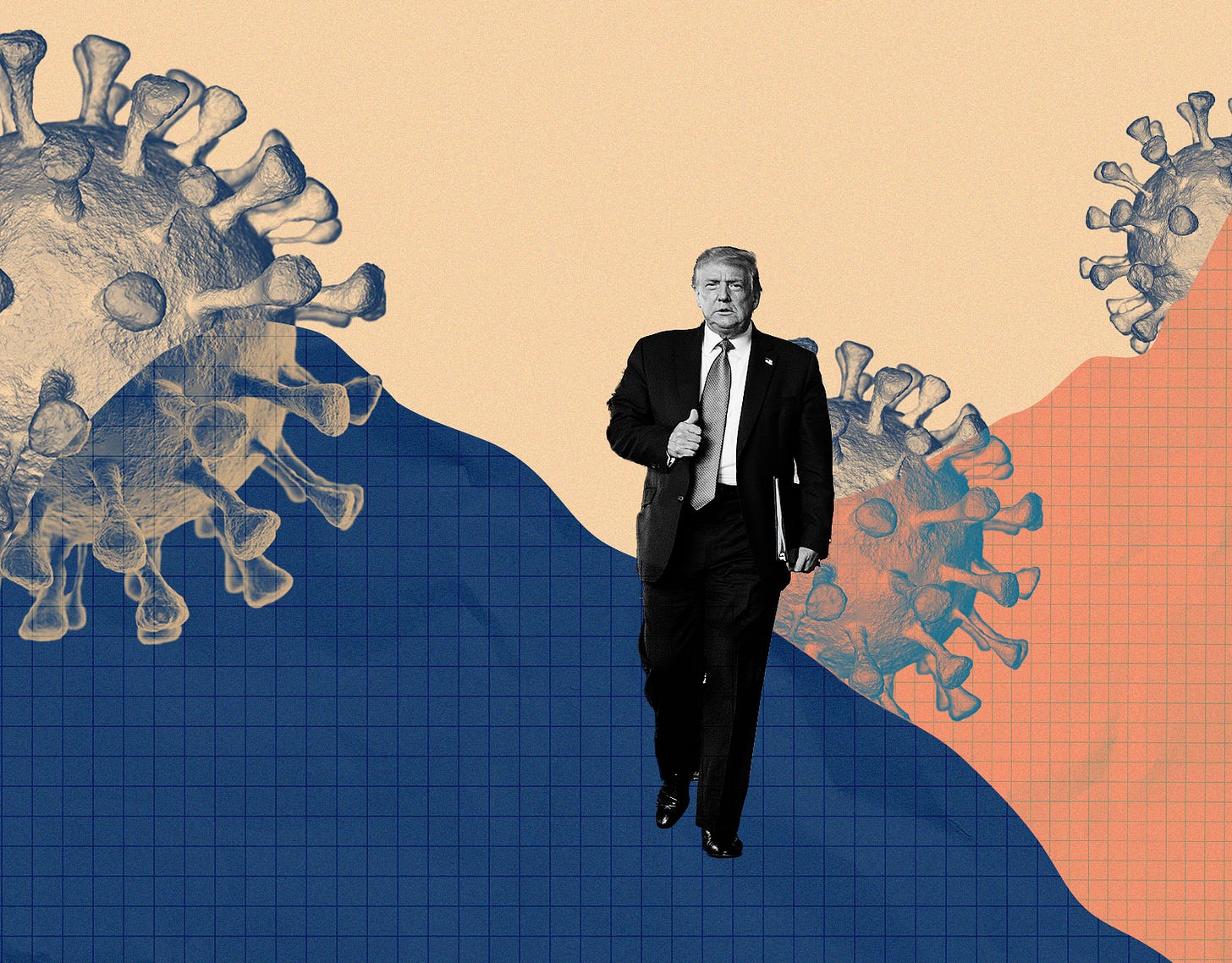
1. The Second Wave
On June 25, I wrote the following:
If the real-world number of infections starts to rise—meaning that we are not just seeing more infections in the testing world for whatever reason—then we will eventually see a corresponding number of deaths. But we won't see it for three or four weeks. . . .
If there is a second wave, then by mid- to late-July we're going to see the daily death numbers start to trend back upward. Well, it's July 16 and the daily death trend is moving. Here's the NYT:

These totals are the net-net of declining deaths in the Northeast and Midwest and rising deaths in the South and West. Here's the Atlantic:

There were (and are) good reasons to suspect that the case fatality rate might be lower during the period, at least in the short run, because: (1) a greater percentage of the infected are younger than was the case during the spring; (2) we have improvements in treatment protocols; (3) a lack of earlier testing this winter/spring might have meant that the original fatality rates were lower than they appeared.
I am still hopeful that the number of deaths as a percentage of diagnosed cases will be smaller—possibly significantly so—during this wave than during the darkest days of April.
But believing that the death rate trend was never going to follow the number of diagnosed infections was magical thinking.
And once again, the Trump administration either willfully misled the American public or had no earthly idea what it was talking about.
Here I will remind you of Mike Pence's ludicrous op-ed which the WSJ dutifully published with no caveats, corrections, or counter-points:
In recent days, the media has taken to sounding the alarm bells over a “second wave” of coronavirus infections. Such panic is overblown. Thanks to the leadership of President Trump and the courage and compassion of the American people, our public health system is far stronger than it was four months ago, and we are winning the fight against the invisible enemy.While talk of an increase in cases dominates cable news coverage, more than half of states are actually seeing cases decline or remain stable. Every state, territory and major metropolitan area, with the exception of three, have positive test rates under 10%. And in the six states that have reached more than 1,000 new cases a day, increased testing has allowed public health officials to identify most of the outbreaks in particular settings—prisons, nursing homes and meatpacking facilities—and contain them.
Lost in the coverage is the fact that today less than 6% of Americans tested each week are found to have the virus. Cases have stabilized over the past two weeks, with the daily average case rate across the U.S. dropping to 20,000—down from 30,000 in April and 25,000 in May. And in the past five days, deaths are down to fewer than 750 a day, a dramatic decline from 2,500 a day a few weeks ago—and a far cry from the 5,000 a day that some were predicting. If Mike Pence understood what was really happening on the ground—and what was obvious to most outside observers—then his piece willfully misled the public with cherry-picked data points.
It's important to underscore here that we're not talking about job reports or economic data or election polling where politicians are entitled to try to put the best possible gloss on the subject because everyone screws around with subjective viewpoints in an attempt to make the case for their side.
We're talking about life and death.
Pence was presenting information to American citizens which would inform decisions they made about what sort of risks were reasonable to take and how to plan their lives in the near-term future.
And he either lied to them or he didn't know better.
I'm not sure which is worse.
2. Brad Parscale
For the last three months I've been pointing out that the Trump digital operation is not a political campaign so much as a marketing scam and that it was clear that Brad Parscale could not keep his job for much longer.
And lo' it came to pass that Brad was cast into the outer darkness.
I'm kidding, of course. Brad only lost his big job. He's still on the payroll because in Trump world, you only get cast out for disloyalty, not incompetence.
Of course, what gets you demoted is neither disloyalty nor incompetence, but the boss seeing people talk about how you're getting rich off of his brand. Check out this nugget:
"Drawing some concerns from Mr. Trump was a May advertisement from the Lincoln Project, a bipartisan group working to defeat the president in November. The ad suggested that the campaign manager was getting rich off Mr. Trump."
Oops.
But before we move on to the Glorious Stepien Era—where the suburbs become Republican again because Stepien once worked for Chris Christie and it's the operatives who move voters, not the candidates—I want to share a couple more Trump campaign come-ons that have been passed my way over the last few days.
The first is a hard-sell that tells the recipient that they have exclusively been awarded the chance to have their donation 500% matched, but that the offer will expire in two hours:

When David didn't respond, the campaign followed up with this stern message:

Don't fail the Dear Leader!
The next example is a claim that the president has both personally requested to meet the recipient but also that the president's request can't be honored unless the recipient enters a contest to win the meeting. (By giving money, obviously).


I know what you're thinking:
Hold on—if the POTUS is requesting that Joe be his guest at the convention, then why doesn't he just invite Joe? He's the leader of the free world! He can do anything he wants! It says so right in the Constitution!
I'm not a lawyer. I don't know what constitutes "fraud" as a legal matter when it comes to advertising. But this solicitation seems to be . . . misleading?
But not all Republicans are running dishonest marketing campaigns. Senator Thom Tillis just sent out this email begging for money:

The image at the top of that email is a gif. Here's what it looks like when it's flashing:

I have to say that this looks awfully close to disloyalty on the part of Tillis.
First off, he's saying that the Democrats are beating President Trump in both fundraising and the polls. Which is, so far as I can tell, not the Official Position of Our Great President.
Second, look at where the red downward arrow is point: Straight at frowny-face Trump.
What's Tillis trying to say here? That Trump is a LOSER?
And finally, look at the composition of the five people in the photo. We have washed out sepia photos of Evil Democrats. Then on the right we have a color version of Frowny Trump. And next to Trump—in a slightly larger size!—we have smilin' Thom. Like he's a bigger deal than Donald J. Trump.
I hope no one shows this to the president . . .
3. Elevator Action
Consider the elevator, in this classic Nick Paumgarten piece from the New Yorker:
Ask a vertical-transportation-industry professional to recall an episode of an elevator in free fall—the cab plummeting in the shaftway, frayed rope ends trailing in the dark—and he will say that he can think of only one. That would be the Empire State Building incident of 1945, in which a B-25 bomber pilot made a wrong turn in the fog and crashed into the seventy-ninth floor, snapping the hoist and safety cables of two elevators. Both of them plunged to the bottom of the shaft. One of them fell from the seventy-fifth floor with a woman aboard—an elevator operator. (The operator of the other one had stepped out for a cigarette.) By the time the car crashed into the buffer in the pit (a hydraulic truncheon designed to be a cushion of last resort), a thousand feet of cable had piled up beneath it, serving as a kind of spring. A pillow of air pressure, as the speeding car compressed the air in the shaft, may have helped ease the impact as well. Still, the landing was not soft. The car’s walls buckled, and steel debris tore up through the floor. It was the woman’s good fortune to be cowering in a corner when the car hit. She was severely injured but alive.











